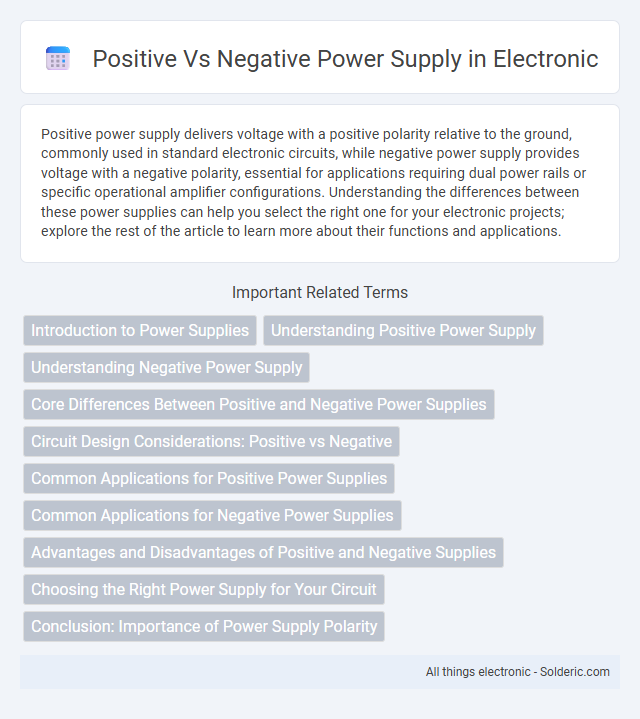Positive power supply delivers voltage with a positive polarity relative to the ground, commonly used in standard electronic circuits, while negative power supply provides voltage with a negative polarity, essential for applications requiring dual power rails or specific operational amplifier configurations. Understanding the differences between these power supplies can help you select the right one for your electronic projects; explore the rest of the article to learn more about their functions and applications.
Comparison Table
| Feature | Positive Power Supply | Negative Power Supply |
|---|---|---|
| Voltage Polarity | Positive relative to ground (e.g., +12V) | Negative relative to ground (e.g., -12V) |
| Common Use | Powering standard electronic devices and circuits | Used in operational amplifiers, dual power supplies, and specific analog circuits |
| Reference Point | Ground or zero volts | Ground or zero volts |
| Effect on Circuit | Supplies current flowing into the load | Supplies current flowing out from the load |
| Voltage Range | 0V to positive max voltage | 0V to negative max voltage |
| Example Applications | Microcontrollers, digital logic circuits | Analog signal processing, audio amplifiers |
Introduction to Power Supplies
Power supplies convert electrical energy into a usable form for electronic devices, categorized as positive or negative based on output voltage polarity relative to ground. Positive power supplies provide voltage above ground, commonly used in standard circuits, while negative power supplies deliver voltage below ground, essential in applications like operational amplifiers and certain analog circuits. Understanding these differences helps you select the correct power supply for your electronic projects to ensure proper functionality and safety.
Understanding Positive Power Supply
A positive power supply provides voltage with a positive polarity relative to a common ground, essential for powering most electronic circuits by delivering current from the positive terminal to the load. It stabilizes the voltage output, ensuring consistent power delivery and protecting sensitive components from voltage fluctuations. Understanding the role of a positive power supply is crucial for designing reliable circuits that depend on precise voltage levels for operation.
Understanding Negative Power Supply
Negative power supply provides a voltage lower than the system ground, essential for devices like operational amplifiers and analog circuits that require dual power rails. Understanding negative power supply helps optimize circuit performance by ensuring proper biasing and signal symmetry. Your designs benefit from improved stability and noise reduction when negative voltage sources are correctly implemented.
Core Differences Between Positive and Negative Power Supplies
Positive and negative power supplies differ primarily in their voltage polarity relative to the ground, with positive supplies providing voltage above ground (e.g., +12V) and negative supplies offering voltage below ground (e.g., -12V). Positive power supplies are commonly used in conventional electronic circuits, while negative power supplies are essential in applications requiring dual or bipolar voltages, such as operational amplifiers and analog signal processing. The core distinction lies in their reference points and current flow direction, influencing circuit design and component selection.
Circuit Design Considerations: Positive vs Negative
Designing circuits with positive power supplies typically involves simpler biasing and more straightforward voltage referencing, making them ideal for single-supply operational amplifiers and digital devices. Negative power supplies are crucial for circuits requiring dual polarity, such as analog signal processing, enabling symmetrical voltage swings and improved linearity in amplifiers. Careful consideration of voltage headroom, ground referencing, and component tolerances is essential when selecting between positive and negative power supplies for optimized circuit performance.
Common Applications for Positive Power Supplies
Positive power supplies are commonly used in analog circuits, microcontrollers, and sensor systems where a stable and regulated positive voltage is essential for proper operation. Your electronic devices, such as op-amps and digital logic circuits, typically rely on positive voltage rails for accurate signal processing and control. These power supplies provide a consistent voltage source that supports reliable performance and reduces noise in sensitive electronic components.
Common Applications for Negative Power Supplies
Negative power supplies are commonly used in operational amplifiers, analog signal processing, and dual power systems to provide voltage levels below the ground reference, essential for accurate signal amplification and processing. Instrumentation equipment and audio amplifiers rely on negative power supplies to achieve proper biasing and improve dynamic range. Your electronic circuits benefit from stable negative voltages for enhanced performance and reduced noise in sensitive applications.
Advantages and Disadvantages of Positive and Negative Supplies
Positive power supplies offer advantages like compatibility with most electronic circuits and simpler design for common devices, but can cause ground reference limitations and voltage drop issues. Negative power supplies provide benefits in applications requiring negative voltage rails, improved signal integrity, and reduced noise, yet they often complicate circuit design and increase cost and size. Understanding these trade-offs helps in selecting appropriate power supply types for specific electronic applications.
Choosing the Right Power Supply for Your Circuit
Choosing the right power supply for your circuit depends on the voltage requirements and polarity needed for proper operation, with positive power supplies delivering voltage above ground and negative power supplies providing voltage below ground. Evaluating the load type, current capacity, and stability ensures your circuit runs efficiently without damage or noise interference. Your selection impacts overall device performance and reliability, making accurate specification matching essential.
Conclusion: Importance of Power Supply Polarity
Power supply polarity plays a critical role in the functionality and safety of electronic circuits. Using the correct positive or negative power supply ensures proper voltage direction and prevents damage to sensitive components. Maintaining correct polarity is essential for optimal circuit performance and longevity.
Positive vs Negative Power Supply Infographic

 solderic.com
solderic.com